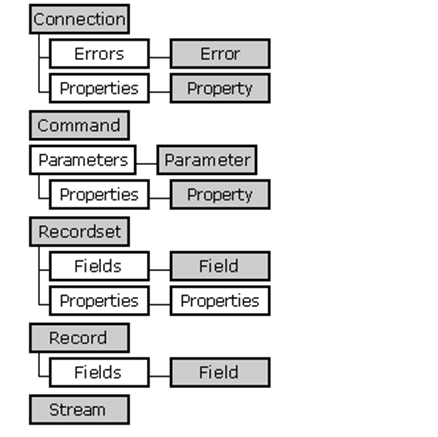 | Documentation |
|---|---|
27.5. ADO Object Model
The Connection, Command, Recordset, and Field objects also have a Properties collection. 27.5.1. ADO ObjectsADO provides two objects for managing connections with data sources (Connection and Command), two objects for managing the data returned from a data source (Field and Recordset) and three secondary objects (Parameters, Properties, and Errors) for managing information about ADO. ADO provides a quick, easy way to access data from a variety of development environments. Command Object It defines a specific command to execute against a data source. The Command object represents a SQL statement or stored procedure that software executes against the data source. Use of Command objects is optional -- data can be extracted directly from a Connection object, if desired. The Command object has the functionality of executing commands to the database. In most cases, the Command object is created implicitly when executing an operation against the database. You can do this with the Connection object's Execute() method, or with the Recordset's Open method. Each of these methods takes as an argument a "Command Text". In the novice examples on this web site, the command text is a SQL statement, as it is likely to be most of the time. When executing a prepared SQL statement, it isn't necessary to use the Command object explicitly. If the query is used to retrieve data, the data will be returned as a Recordset object. This means that the retrieved data can be manipulated by properties, collections, methods, and events of the Recordset object. The major feature of the Command object is the ability to use stored queries and procedures with parameters. Connection Object It represents an open connection to a data source. The Connection object sets up a link between your program and the data source. This object contains all of the necessary configuration information and acts as a gateway for all of the other ADO objects. The Connection object is mandatory -- all implementations of ADO must support it. The Connection object is the "pipeline" of data. It contains all of the information necessary to connect to the database, and a good number of methods as well that enable us to work with the data, and even retrieve information about errors, or the structure of the database itself. When a Connection object is open, it is using resources on the server that should be freed up as quickly as possible. Therefore, while closing and destroying a Connection is handled implicitly, without any interference from you, it is always best to explicitly open, close, and destroy the Connection object. That said, it would seem convenient to use the Connection object to retrieve Recordsets, since the Open method of the Connection returns a Recordset when a query returns a Recordset. In fact, creating the Connection object can be used very effectively for queries which do not return Recordsets, such as "INSERT" "UPDATE" or "DELETE" queries. Recordset Object It represents the entire set of records from a database table or the results of an executed command. Each command execution results in a Recordset containing the results of the query. This object is a mandatory part of ADO. Field Object It represents a column of data with a common data type. Each Recordset object is composed of a number of Field objects that represent individual columns in the Recordset. This object is a mandatory feature of ADO. Parameter Object It represents a parameter or argument associated with a Command object based on a parameterized query or stored procedure.Command objects may have an associated collection of Parameter objects that provide additional information to the data source when executing the command. The Parameter collection is optional. Error Object It provides specific details about each ADO error. The Error object represents an error encountered by the ADO objects, especially on the data provider. Property Object It represents a dynamic characteristic of an ADO object that is defined by the provider. This object is not currently supported on UNIX. |
